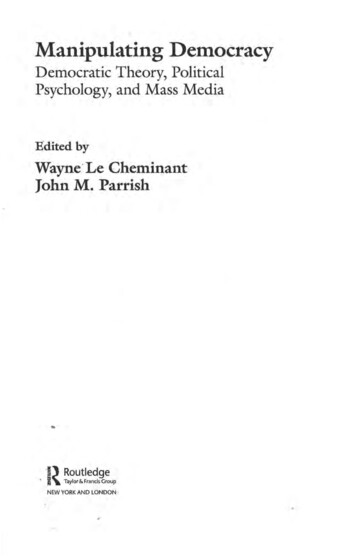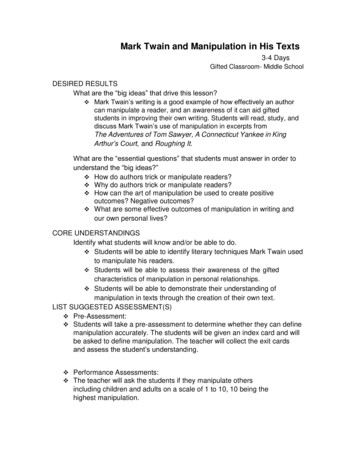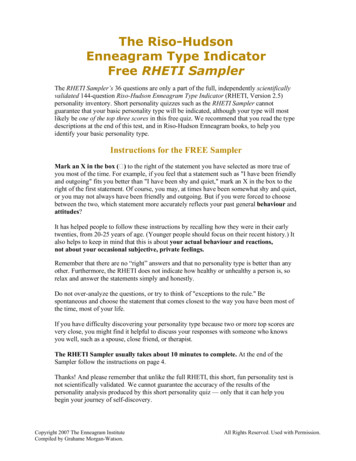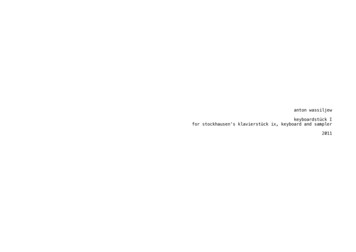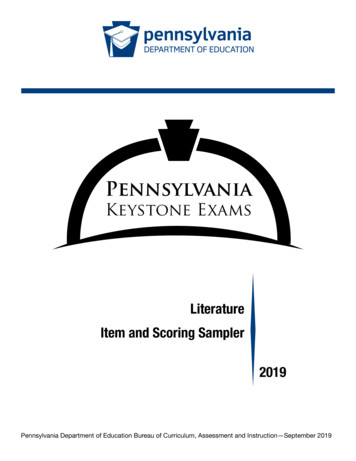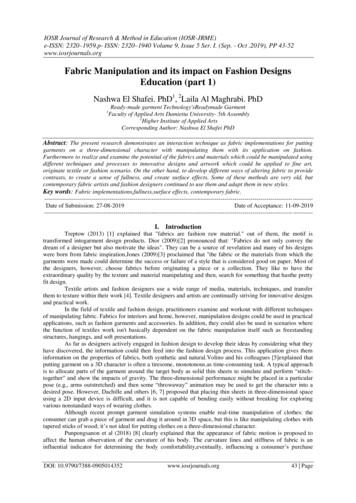
Transcription
Visceral Manipulation:Study Guide Sampler(VM1 and VM2)COPYRIGHT NOTICE 2007 THE BARRAL INSTITUTEAll rights reserved.No part of this study guide sampler may be reproduced or transmitted in any form or by any meanswithout the written permission of the publisher.Future Editions of Study GuidesThis work is constantly evolving resulting in updated versions of the study guide.As alumni of this course, you are eligible to purchase all updated versions of the study guide at cost.For additional copies of this study guide, please contact: www.barralinstitute.com
Visceral Manipulation: Abdomen 1 (VM1)Introduction“No one argues with the wine tester who, by using his palette, can tell usthe characteristics of a wine – its region, its vineyard or even its vintage.The education of touch can go at least as far.”—Jean-Pierre Barral, D.O.This study guide is about the education of touch. Who is better to teach us than Jean-Pierre Barral, thedeveloper and connoisseur of Visceral Manipulation? Jean- Pierre was born on September 25, 1944 inGrenoble, France. He began his career as a registered physical therapist then went on to pursue adoctorate in Osteopathy.Working at the Lung Disease Hospital in Grenoble, he trained under Dr. Arnaud, a recognized lungspecialist and a master of cadaver dissection. Under Dr. Arnaud’s supervision, Jean-Pierre had theopportunity to perform extensive cadaver dissections himself. What intrigued him most was the postmortem condition of body tissues in former patients. Having known these patients, treated them,taken their medical histories and worked on their bodies, he was further able to observe the internalcondition and relate what he saw to what he felt. Jean-Pierre consistently observed extensive tissuethickening around the viscera, which he realized was causing an altered mechanical tension onsurrounding tissues. This discovery led him to the theoretical and practical development of viscerallistening techniques.Jean-Pierre went on to teach Spinal Biomechanics at England’s European School of Osteopathy from1975 to 1982, all the while continuing to develop his practice. For this period of time his primary toolwas manipulation. Then one of his patients, a gentleman complaining of back pain, showed a markedimprovement, not however from his osteopathic manipulation. This patient had visited a folk healer inthe Alps who pushed something in his abdomen.Barral noted how effective this visceral “adjustment” was to his neuromusculoskeletal problem andpursued this direction in his research. He came to see the significant relationship between viscera andsomatic dysfunction. He discovered that structural relationships (musculoskeletal, spinal, cranial)would self-correct after proper Visceral Manipulation. It became apparent that Visceral Manipulationaffected many body systems.Students have been able to study Jean-Pierre’s approach to visceral manipulation and to observe hiswork at the Institute symposiums, where practitioners presentdifficult cases for his evaluation andtreatment. In what appears to be a very simple examination in a very short time – a matter of minutes– Jean-Pierre gives an accurate medical and surgical history, without exchanging a word with thepatient. He explains, “I prefer to speak to the tissues not so much the person.” He receives hisinformation not from telepathic connection to the patient’s mind, but from simply listening with hishands to the story the tissues have to tell.Barral Institute – 866.522.77252
What is Visceral Manipulation?“The purpose of Visceral Manipulation is to recreate, harmonize and increase proprioceptivecommunication in the body to enhance its internal mechanism for better health.”—Jean-Pierre Barral, D.O.Visceral Manipulation is a manual therapy consisting of gentle, specifically placed manual forces thatencourage normal mobility, tone and inherent tissue motion of the viscera, their connective tissue andother areas of the body where physiologic motion has been impaired.Motion is a sign of life itself. Everything in the universe is in motion. Everythingmoves in space andtime and humans are no exception to this rule. Our bodies need movement to be healthy. This sameprinciple applies to every structure in our bodies including the viscera. For an organ to be healthy andhave optimal function there needs to be motion.Tissues lose their normal motion when they become inflamed. The natural healing process involveslocal disruption of normal tissue fibers and their replacement with relatively inelastic granular tissue.It can be conceptualized as a localized drying-out of the affected tissues. Many factors can causetissue inflammation including: infections, direct trauma, repetitious movement, diet, environmentaltoxins and emotional stress.As a student of Visceral Manipulation you will learn tools for evaluating organ motion, in particular,two types of movement: one motion caused by the pushes and pulls of the surrounding tissues(mobility) and the other, the organs own intrinsic, active motion (motility). You will also learntechniques to treat these areas of decreased/altered motion, thereby restoring better physiologicmotion, which in turn will improve the function of that organ.Barral Institute – 866.522.77253
MobilityVisceral Mobility is the movement of the viscera in response to external forces.Voluntary movement, or involuntary movement, such as the diaphragm withrespiration or the heart beating, create these external forces that push and pull onthe viscera.For the viscera to function properly, each organ needs to be able to glide and slidein relationship to all the other tissues without any restrictions. A restriction, fixationor adhesion to another structure, no matter how small, implies functionalimpairment of the organ.MotilityThe viscera have an intrinsic active motion which we call motility. Visceral motilityis perceptible to the hand but requires an educated sense of touch. It is thekinetic expression of tissues in motion. The movement of motility is individualfor each organ and traces the path of embryological development and migration.The embryologic theory of visceral motility postulates that the axes and directionof these motions remain inscribed in the visceral tissues. Thus, visceral motilityoccurs around a point of equilibrium, oscillating between an accentuation of theembryologic motion and a return to the original position.The motility cycle has two phases in which the organs move toward and awayfrom the median axis of the body. We call these phases “expir” and “inspir”respectively. The two phases make up one cycle of movement. The rhythm ofvisceral motility is characteristically 7 – 8 cycles per minute.Barral Institute – 866.522.77254
OrgansThere are a number of systems that work together to support and hold theabdominal organs in their place while still allowing for full physiologic motion.Three of the main systems are:1.Double Layer System2.Turgor3.Intracavitary pressuresThe double layer system occurs where two serous membranes come into contact.All of the structures in the abdomen are wrapped in a serous membrane. Theserous fluid produced from these membranes creates a suction affect between thetwo layers, which holds the two structures together while still allowing for glidingand sliding over each other.Turgor acts upon the hollow, intraperitoneal organs. The pressure within the holloworgans is greater than the pressure outside of them. The hollow organs thereforeexpand, occupying the maximal amount of space made available for them.In the body, each cavity has either a positive or negative pressure. The negativepressure of the thoracic cavity plays an important role in support of the abdominalorgans. This negative intrathoracic pressure creates an upward force on theabdominal viscera. The force of gravity in the abdominal cavity acts against thisupward force. Together, these two opposing pressures work to maintain a dynamicbalance. The negative intrathoracic pressure is very powerful and has its strongestaffect on the organs just underneath the diaphragm, constantly attracting themupward.An understanding of the systems that support and hold the abdominal organs inplace helps explain why the liver, an organ that is quite heavy, is held in the righthemi-diaphragm. The liver would not be able to maintain its position if it werenot for the attractive force of the thoracic cavity. This negative pressure of thethorax helps to hold the liver in place.Barral Institute – 866.522.77255
PeritoneumBarral Institute – 866.522.77256
Treatment Considerations1.Visceral Manipulation is characterized by high precision and minimal force.2.Use soft relaxed hands and let go of any tension within your own body.3.Let your mind be open, aware and neutral, without any urgency to succeed.4.Do not blend with your client. Stay separate and objective as you treatthem. Do this both physically and mentally. You will be much moreeffective this way and have more energy for it.5.With Visceral Manipulation a little bit goes a long way. When treating,listen to the tissues, follow the tissues and assist them to release tensionwhere they are restricted. Begin this process and then let the body takeover.6.For each case you must tune into the patient and feel the rhythm, vitalityand resistance of the tissues you are working with. Listen and follow. Wewant to stimulate the patient’s forces of auto correction. A treatment doesnot finish when our treatment time is over, it continues on for days, weeksand longer.7.The key to Visceral Manipulation is developing your listening skills andyour understanding of anatomy.Barral Institute – 866.522.77257
Contraindications and PrecautionsUsing alternative or natural medicine should not mean rejecting the techniques ofconventional medicine. In case of any doubt do not hesitate to use resources; referout as necessary.Contraindications – use your common sense.1.An acute flare up of an inflammatory process(i.e., rheumatoid arthritis, colitis, fever)2.Abdominal aneurysm3.Bleeding ulcer4.Thrombosis5.Hemorrhage or fracture6.Pregnancy (can perform motility & sphincter work)Precautions – use a lighter touch in these cases because the tissues have greaterfragility.1.Diabetes2.Patients taking anticoagulant drugs or cortisone3.After radiation therapy, chemotherapy4.Dilation of superficial veins (varicosities)5.Foreign body – IUD, pacemaker, stintsBarral Institute – 866.522.77258
Visceral Articulations of the LiverBarral Institute – 866.522.77259
Liver — General InformationVascularizationArtery: celiac trunk hepatic arteryVein: portal vein hepatic vein inferior vena cavaInnervationSympathetic: cord level T7-T9; through greater splanchnic nerve celiacplexus hepatic plexusafferent impulses carried through the phrenic nerve C4-C5 levelParasympathetic: vagus nerveGeneral ListeningRight side bending accompanied by a slight left rotation around an axis that goesthrough rib 9-10 on the right.Local ListeningWith hand on patient’s abdomen, middle finger along midline and palm onumbilicus, one’s hand is drawn to the right hypochondrium rotating clockwiseand moving superiorly.Emotional/PsychologicalThe liver is the organ of identification of one’s deep self, the root of one’s personality.The liver reacts to the intense anguish, cyclic rage, strong fears and/orunbearable difficulties.Barral Institute – 866.522.772510
Associated Skeletal Restrictions C4-5 right side or bilateral Right scapula Right glenohumeral periarthritis Cervical/brachial plexuses and associated fascia T7-10 R7-10 — lower ribs and right costovertebral articulations Cranial base restrictions — right side Frontal/nasal articulation — right side Left sciatica — venous hepatic origin Right sciatica — related to restrictions of:hepatic fascia, right kidney, ascending colon Right parietal, temporal and sphenoid bonesBarral Institute – 866.522.772511
Liver Lift/Release Mobility Evaluationand Treatment TechniqueBarral Institute – 866.522.772512
Liver Mobility Testing/Treatment —Transverse PlaneNotes:Barral Institute – 866.522.772513
Liver Mobility Testing/Treatment —Transverse PlaneAnteriorLiverStomachPosteriorBarral Institute – 866.522.7725InferiorVena Cava(Axis ofMotion)14
LiverMobility Testing/Treatment —Coronal (Frontal) PlaneNotes:Barral Institute – 866.522.772515
Visceral Manipulation: Abdomen 2 (VM2)IntroductionWelcome to Visceral Manipulation: Abdomen 2 (VM2). As you begin this course, you will soondiscover that it is quite different from Visceral Manipulation: Abdomen 1. Rest assured, this isintentional. Each course in the curriculum is designed to build upon the one before it, alternatingbetween classes that focus on academic concepts with those that reinforce your understanding ofthose concepts by stressing hands-on applications.VM2 is a highly conceptual and experiential class. In keeping with that format, this study guide isintended to be used as a dynamic, interactive learning tool. We have included plenty of space onboth written pages and illustrations for you to record your observations as you experience them inclass. We believe this active participation on your part helps reinforce your memory of the VMmaterial by involving more of your senses in the learning process.In this course, we will assume that you have become acquainted with the feel of the differentorgans and local restrictions. With this familiarity established, we can now add more informationabout the manipulations by adding more whole-body involvement via the long lever techniques.These require you to FEEL several things at once:1. The local specific structure to be tested and manipulated.2. The related structures, textures, tones, tensions, motions.3. Local restrictions.4. The tensionsthat local restrictions produce in both surrounding and distanttissues and structures as we move the body through space.In order to properly perform items 3 and 4, items 1 and 2 must be almost second nature to you.(Some time will be spent in review to clear up questions and clarify your perceptions.)This “Integration of Techniques Concept” will add a deeper understanding of direct techniques,indirect techniques, stacking, long levers, combining and stacking long levers, and recoil.Please note that long lever techniques incorporate increased mechanical advantage. This means thatvery little force is required for them to be effective. Please respect the power of these techniques.In order to focus on the motions of the tissues and their subtle elastic qualities for ourmanipulations (rather than physically moving something), our hands as well as bodies must remainsoft, open and receptive to this information. We want to be able to perceive when the bodyresponds to the information of our manipulations and begins to take over. This is not possible whenwe are focused on our own manual forces.In our interaction with the intelligence of the tissues that we are striving to assist, we must keep inmind first and foremost that we cannot force any change that is counterproductive to theoptimalfunctioning of each person’s bodyBarral Institute – 866.522.772516
Review Mobility — g/Treatmentfor VerticalMotionNotes:Transverse/Vertical MotionCombinedRestrictions inthe Region ofthe Liver andLesser OmentumBarral Institute – 866.522.772517
Review Motility — StomachHand placement for motility or local listening to the stomach.Motility of Stomach With LiverBarral Institute – 866.522.772518
Stomach - Hiatal HerniaThe hiatal area is that aspect, a transition zone, where the esophagus enters the stomach.This hiatal area is also known as the gastroesophageal area.At this region there is a very delicate, mechanical balance of tissue tensions. The thorax hasa negative pressure system and the abdomen has a positive pressure system. Structures areattracted to a negative pressure system, so anything that interrupts this delicate interchangeof pressures can create a hiatal hernia.Causes can be: Mechanical (i.e., kyphosis, obesity, hypertonicity or hypotonicity of the diaphragm) Emotional Hormonal (i.e., menopause) Dietary irritants (i.e., caffeine, alcohol or acidic foods)The topography for this gastroesophageal junction is the left 7th sternochondral junction andT10 T11 posteriorly, as these are the levels at which the esophagus penetrates thediaphragm.There are two types of hiatal hernia: sliding and paraesophageal. A sliding hiatal hernia iswhen the mucosa of the stomach slides superiorly into the esophagus. This is a much lessdangerous condition than the paraesophageal hernia. In this case, instead of the mucosasliding into the esophagus, it slides up next to the esophagus. Strangulation and gangrenecan occur. These clients are very ill, with vomiting and inability to eat, and they often endup in the emergency room.The mucosa of the esophagus is alkaline and the stomach is an acid environment. Refluxcan occur when the delicate mechanical balance is disturbed, creating a condition known asgastroesophageal reflux disease (GERD). Antacid medication is the number one over-thecounter medication, sold to the tune of billions of dollars each year. The manual techniquesshown on the following pages, along with sphincter work, dietary considerations andcreating changes in stress levels, can all have a positive effect in this hiatal area.Barral Institute – 866.522.772519
Creating Stretch at Esophageal Hiatusto Restore Balance at ThisCommonly Stressed AreaAlternate hand placement for manipulatingthe superior stomach with thethoracic esophagus.Barral Institute – 866.522.772520
Follow Rotational TendenciesUntil Release Is PerceivedFinding the superior stomach.Can do vertical or transverse glidesin this hand placement.Barral Institute – 866.522.772521
The KidneysThe kidneys are of particular importance in Visceral Manipulation. As Jean-Pierre says,they are “key organs.” Renal disorders have wide repercussions.Etiology of kidney dysfunction can be metabolic, emotional or mechanical. We will focusprimarily on mechanical functioning knowing that a fixed kidney is pathological.One of the principles in visceral work is that mobility is of greater significance thanposition. Reference: Visceral Manipulation by Jean-PierreBarral, DO, page 189. Theprimary mechanical pathology of the kidney is ptosis (or prolapse).Few people are aware of the magnitude of renal metabolic activity. The kidneys take up1/140th of the body’s weight and utilize 1/8th of the body’s O2. The kidneys, along with theliver, play a significant role in detoxifying our bodies. The kidneys (and liver) are alsoresponsible for the deep energies of our body. Indeed, the kidney-liver relationship is sostrong that liver dysfunctions are generally an indication for treatment of the kidneys.Notes:Barral Institute – 866.522.772522
Visceral Articulations of the KidneysThe illustration shows: The right lobe of the liver articulates with the right kidney via thehepatorenal ligament. The adrenal glands sit on the superior medial aspect of each kidney. The hepatic flexure of the colon articulates with the right kidney. The descending duodenum (D2) articulates with the hilum of the rightkidney. The left kidney articulates with the stomach. The middle part of the anterior left kidney articulates with the pancreas. The inferior part of the left kidney articulates with the duodenojejunalflexure and loops of the jejunum. On the lateral aspect of the left kidney is the splenic flexure of the colon. There is an articulation with the spleen and the left kidney via thesplenorenal ligament (lienorenal ligament).Barral Institute – 866.522.772523
Visceral Articulations of the Kidneys(Anterior View)Right KidneyLeft KidneySpleenSuprarenal exureDescendingColonTransverse ColonJejunumKidney Articulation With PosteriorAbdominal Wall (Posterior Barral Institute – 866.522.772524
Kidneys – General InformationVascularizationArtery: Renal arteriesVein: Renal VeinsInnervationSympathetic: cord level T10-T12; through splanchnic nerves to renal plexus;formed by celiacganglion and plexus, aorticorenal ganglion and aortic plexus.Parasympathetic: vagus nerveGeneral ListeningThe patient first side bends toward the side of the restricted kidney and thenrotates toward that side and forward bends.Local ListeningWith the patient in a supine position, place the heel of your hand just above theumbilicus and the middle finger on the midline. When there is a renal problem,the palm is pulled deeply posterior then laterally to the right or left, dependingon the affected kidney; with a pull then slightly superomedially.If there is a renal ptosis the palm moves initially away from the midline. For asecond-degree ptosis, the hand moves inferolaterally, and for a third-degree ptosisit moves inferomedially.Utilizing both local listening and listening for motility is essential.Reference: Visceral Manipulation II by Jean-Pierre Barral, DOMotilityInspir: inferior/lateralExpir: superior/medialEmotional/PsychologicalThe left kidney is the organ that relates to our genetic roots, our roots of “being.”The right kidney is associated with frustrated, intense anger. It relates to events“too emotional” for the liver.Barral Institute – 866.522.772525
Associated Skeletal Restrictions Vertebral restrictions of T7, T11, T12 and their associated ribs Vertebral restrictions of L1-L4 Dysfunction of the lower limb, particularly the tibiofibular joint, knee,navicular, 1st cuneiform, 5th metatarsal Sacroiliac joint Glenohumeral periarthritis Left kidney can yield a restriction of the coccyx, the left 1st rib andleft cervical spine.Barral Institute – 866.522.772526
Kidney Fascial RelationshipsSuperior View of Both Kidneys(Transverse rtaCavaColon(Dotted Line)PeritoneumLeftRt.CrusCrusPsoas PsoasFascia ofToldtSplitting of TransversusSagittal View ofRight KidneyFascia to BecomeRenal Fascia (Anteriorand erior)Right t ColicFlexurePosterior RenalFascia and IliacFasciaIliacusBarral Institute – 866.522.772527
Kidney TopographyAnteriorPosteriorBarral Institute – 866.522.772528
Kidneys and Related OrgansBarral Institute – 866.522.772529
Left Kidney — Medial RotationShowing thetesticular/ovarianveins and theirrelationship withpotential internalrotation of theleft kidney.Notes:
Locating Kidney5-7 cm.3cm.1210-cm.6-7cm.10 cm.2 cm.Finding the inferior border ofthe right kidney.Finding the inferior border ofthe left kidney.Comparative view of inferior polesof the right and left kidneys.31
Barral InstituteCurriculum Flow Chart32
VM and NM Curriculum UpdatesVisceral Manipulation CoursesVisceral Manipulation: Abdomen 1 (VM1)(Corresponds to previous VM1A.)Course Length: 4 Days24 CE’sSynopsis: In VM1 you will study the models and theories of functional biomechanics as viewedfrom Barral's innovative approach.Course Highlights: Learn manual skills to locate, evaluate and normalize primary areas of dysfunction withinthe abdominal cavity.Explore the dynamics of motion and suspension in relation to organs, membranes andligaments.Examine the relationship of organs and structural or neuromusculoskeletal dysfunction.Assess the quality of functional activity and somatic structures as they relate to an overallpattern.Prerequisite: Experience with sensitive, light-touch palpationRequired Advance Reading: Visceral Manipulation by Jean-Pierre Barral, RPT, DO; Atlas ofHuman Anatomy by Frank Netter, MD, or A Regional Atlas of the Human Body by CarmineClemente.Visceral Manipulation: Abdomen 2 (VM2)(Corresponds to previous VM1B.)Course Length: 4 Days24 CE’sSynopsis: In Visceral Manipulation: Abdomen 2 you will expand on the functional anatomy,hand placements and techniques you learned in Visceral Manipulation: Abdomen 1 to give you adeeper understanding of the abdominal cavity and its relationship to the cranial and thoraciccavities.Course Highlights: Explore the deeper structures within the abdominal cavity, focusing on the kidneys,pancreas, spleen, greater omentum, peritoneum, and their connective or suspensorytissues.Learn about the concept of restriction planes, mobility and motility.Begin to incorporate multiple long-lever techniques into your VM work.33
Participate in supervised, hands-on sessions that guide you through specific techniquesfor locating and evaluating each organ, along with the effects and contraindications.Prerequisite: VM1 (Abdomen 1) or VMIA (Visceral Manipulation IA).Required Advance Reading: Visceral Manipulation II by Jean-Pierre Barral, RPT, DO.Visceral Manipulation: The Pelvis (VM3)(Corresponds to previous VMII. May go into VM5 after having previous VMII.)Course Length: 4 Days24 CE’sSynopsis: Visceral Manipulation: The Pelvis (VM3) studies the relationship between functionaland structural mechanics of the pelvis.Course Highlights: Learn to identify, receive and conduct Jean-Pierre Barral’s method of evaluation andtreatment for the organ systems of the pelvic cavity, including the integration of thepelvic organs with the complex ligament systems of that body region.Discover techniques for differentiating between somatic and visceral causes for pelvicand low back problems.Discover how to integrate the pelvic organs with the complex ligament systems of thebody region.Explore additional principles of direct and indirect approaches and their appropriateapplications.Integrate the pelvis into the body with principles of Lines of Tension.Prerequisite: VM2 (Abdomen 2) or VMIB (Visceral Manipulation IB).Required Advance Reading: Urogenital Manipulation, by Jean-Pierre Barral, RPT, DO.Visceral Manipulation: The Thorax (VM4)(Corresponds to previous VMII. May go into VM5 after having previous VMII.)Course Length: 4 Days24 CE’sSynopsis: After taking Visceral Manipulation: Abdomen 1 and 2, you've become acquainted withthe feel of the different abdominal organs and local restrictions. In the Thorax workshop, you'lltake an expanded look at the functional biomechanics of the thoracic cavity. You'll also explorethe relationship between the hard frame and soft frame with its countless articulations forrespiration, circulatory requirements and upper body movement patterns.Course Highlights: Explore visceral fascia of the throat and thoracic cavity.Review the anatomy, biomechanics and function of the thoracic organs.Study the biomechanics of the cervical, thoracic, rib cage and shoulder girdle complex.Learn techniques to release the soft tissue components of the thoracic inlet and hyoidapparatus.34
Practice listening techniques within the thoracic activity.Understand practical integration of the thoracic cavity organs.Learn integration of the thoracic organs with the complex ligament systems of that bodyregion.Discover techniques for differentiating between somatic and visceral causes for thoracicand spinal problems.Special Focus on Pleura, Lungs, Pericardium, Heart, Mediastinum, Thyroid, Trachea,Esophagus, Sternum, Rib Cage and Thoracic Plexuses.Prerequisite: VM2 (Abdomen 2) or VMIB (Visceral Manipulation IB).Required Advance Reading: The Thorax, by Jean-Pierre Barral, RPT, DO.Manual Thermal Evaluation and Introduction to VisceroEmotional (VM5)(Corresponds to previous Advanced Visceral.)Course Length: 4 Days24 CE’sSynopsis: VM5 studies the use of Manual Thermal Evaluation to evaluate and improve organfunctions.Course Highlights: Learn the use of Manual Thermal Evaluation to find restrictions and organ dysfunction inthe body.Explore the synchronicity between the body and brain, and how that affects the health ofa person.Discover how the brain uses the internal organs to discharge and express excess energy(often of emotional origin) and how that affects structural integrity.Practice working with energy loss, locating structural restrictions contributing to pain,and managing a therapeutic session.Prerequisite: VM3 (The Pelvis) and VM4 (The Thorax).Required Advance Reading: Manual Thermal Evaluation by Jean-Pierre Barral, RPT, DO andUnderstanding the Messages of Your Body by Jean-Pierre Barral, RPT, DO.VisceroEmotional Relationships (VM6)(Corresponds to previous Advanced Visceral II.)Course Length: 3 Days18 CE’sSynopsis: Explore in depth the connections between our organs and our emotions.Course Highlights: Explore the body and the organism, physical energy, psychoemotional energy and releasetechniques all with respect to Jean Pierre Barral’s unique visceral approach.Discover all three levels of Manual Thermal Evaluation, active and passivetissuloemotional liberation, and psychoemotional liberation.35
Understand the Chicken-or-Egg Syndrome in relation to organ dysfunction and emotions.Learn how to break the visceroemotional cycle through Visceral Manipulation.As a workshop that would typically be offered at the post-graduate level, this courseengages course participants in a dynamic exchange of information tailored to advancedskills.Prerequisite: VM5 (Manual Thermal Evaluation and Introduction to VisceroEmotional).Required Advance Reading: Understanding the Messages of Your Body by Jean-Pierre Barral,RPT, DO.Visceral Manipulation: Applications for Pediatrics (VAP)Course Length: 4 Days24 CE’sSynopsis: Visceral Manipulation: Applications for Pediatrics applies Visceral Manipulationtechniques to working with infants, toddlers and childrenCourse Highlights: Learn how early therapy on newborns and infants can possibly reduce the percentage ofproblems later in life.Explore embryology and the developmental landmarks (normal and abnormal) that occurmonth by mon
Visceral Manipulation is a manual therapy consisting of gentle, specifically placed manual forces that encourage normal mobility, tone and inherent tissue motion of the viscera, their connective tissue and other area
